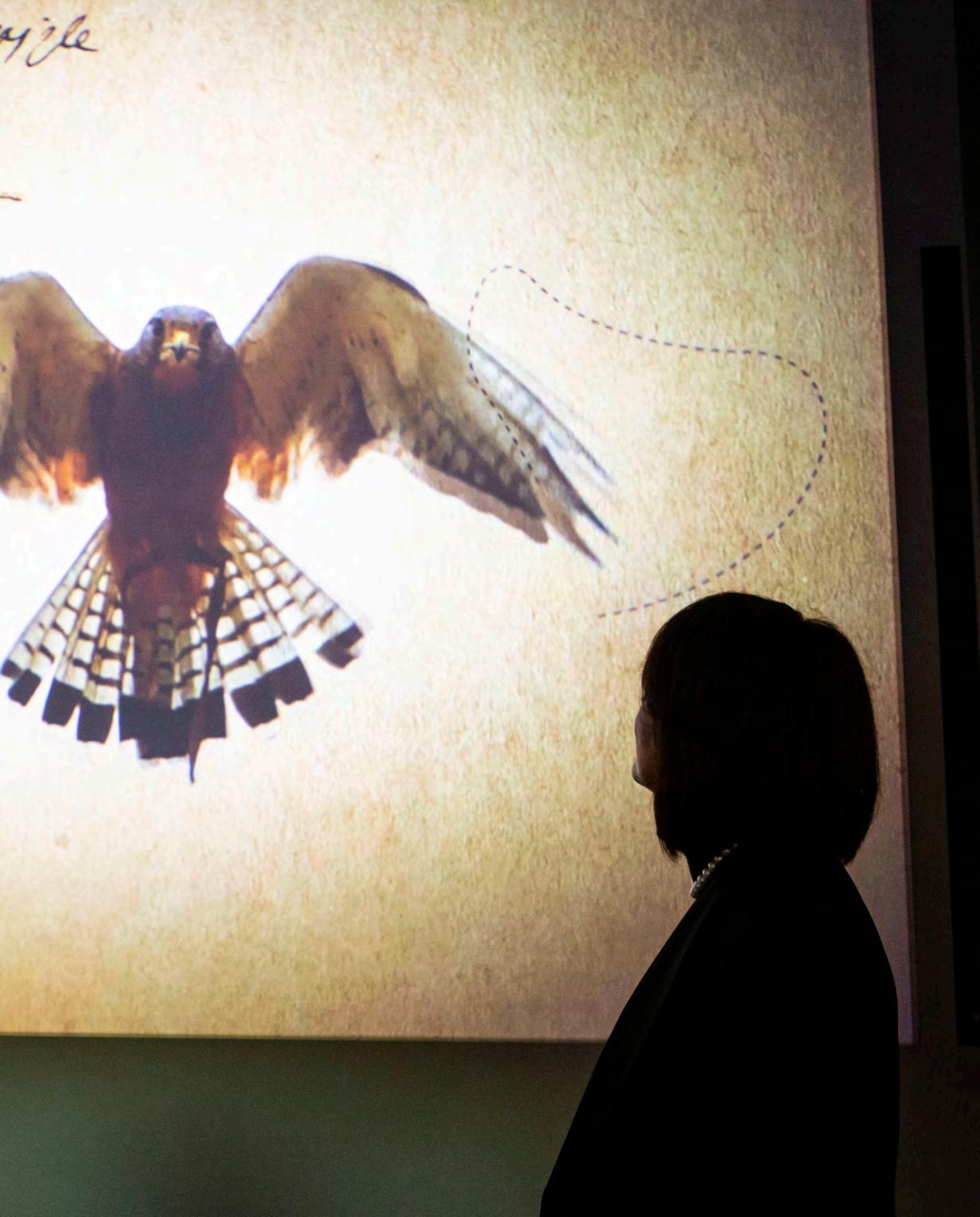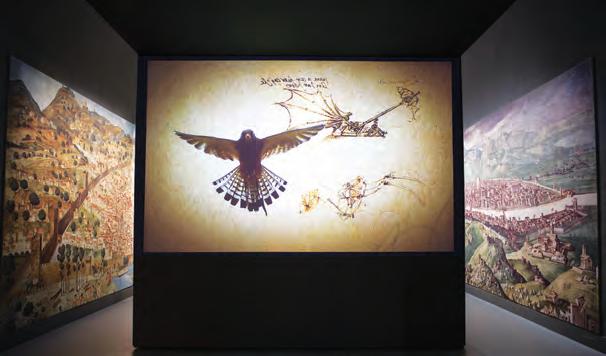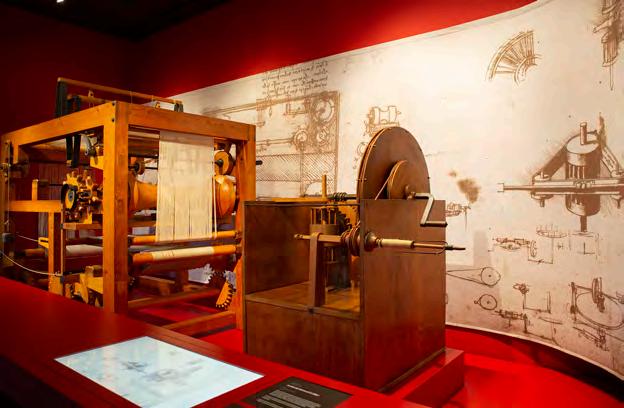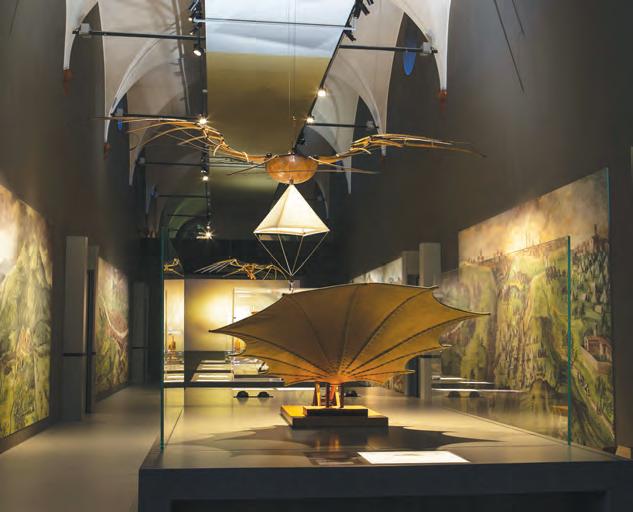
18 minute read
Nuove gallerie Leonardo da Vinci
from Connessioni N. 54
by Pentastudio
La multimedialità al più importante museo scientifico d’Europa
Chiara Benedettini e Damiano Simoncini
Lavorare in sinergia e trovare soluzioni dedicate, adattabili ma al tempo stesso performanti è la ricetta utilizzata da Euphon per l’allestimento della nuova esposizione permanente al primo piano del Museo Nazionale della Scienza e della Tecnologia Leonardo da Vinci di Milano
www.museoscienza.org www.ggroupinternational.com/euphon-m54 www.euromet.com
Un lavoro complesso, per diversi motivi: un progetto preesistente da rivedere e modificare, un parco materiali già definito precedentemente, la necessità di intervenire in ambienti particolari, dove coniugare per richiesta del committente innovazione tecnologica, facilità gestionale e mimetizzazione visiva dei prodotti installati. Cui va aggiunta la necessità di realizzare il tutto in tempi brevi.
GALLERIA LEONARDO DA VINCI
La collaborazione tra i Musei Reali di Torino, la Soprintendenza Castello di Milano, l’Institut de France di Parigi, la Royal Collection di Windsor e di oltre 70 istituzioni culturali di tutto il mondo ha permesso la creazione di un percorso iconografico dedicato alla figura e all’opera di Leonardo da Vinci. Il progetto del percorso è stato affidato al noto museografo François Confino: insieme allo Studio di Architettura LLTT, e grazie anche al pertinente contributo dei professionisti del Museo, ha creato ambientazioni molto scenografiche ma ricche di tecnologia per coinvolgere il visitatore in un viaggio alla scoperta di Leonardo ingegnere e umanista, straordinario uomo del suo tempo.
La Galleria mette in scena oltre 170 opere: (70 modelli e plastici storici, 33 naturalia, 18 volumi antichi, 17 calchi, 14 affreschi e dipinti, 6 manufatti antichi, 13 facsimili storici) e mettere in scena è la parola giusta per descrivere un allestimento dal sapore teatrale e dove di tecnologia ce n’è molta, poco visibile, ma sempre funzionale al progetto. L’installazione finale si compone infatti di 39 installazioni multimediali (23 audiovisivi, sei interfacce esplorabili, otto disegni animati, due installazioni sonore), per oltre 1.300 mq di esposizione: le molte videoproiezioni e videomapping, hanno portato la necessità di installazioni ad hoc per restituire l’effetto desiderato, dal posizionamento in portrait allo stacking, dal warping fino all’appendimento.

IL PROGETTO
La Galleria, di forma a “T” con alcune salette separate, si trova al primo piano del museo, un lungo corridoio lungo più di 100 metri e largo 30, che il progetto della mostra ha poi suddiviso in un percorso tematico di sette aree dedicate, ripercorrendo le varie fasi della vita artistica e lavorativa di Leonardo. Il Museo aveva la necessità di apportare alcune variazioni a un precedente progetto tecnologico risalente ad alcuni anni prima, utilizzando il materiale già acquistato (circa 35 videoproiettori Sony della serie VPL da installazione, con tecnologia 3LCD), e aggiungendo alcuni ingredienti che si erano precisati in itinere, in primis la gestione automatizzata delle sale, in modo da poter accendere e spegnere i vari scenari previsti con un solo comando o escludere facilmente dalla visita sale con guasti, seguito dalle necessità di paging per escludere il suono di alcune sale, specialmente in previsione di interviste, eventi, servizi televisivi. L’incarico realizzativo è stato affidato al general contractor Bodino, il quale ha delegato progettazione e allestimento degli aseptti tecnologici a Euphon, oggi parte di G Group International; il responsabile del progetto è stato Luca Biselli, Project Manager di Euphon: “Abbiamo consegnato il lavoro a dicembre del 2019 dopo soli cinque mesi dal primo contatto; abbiamo curato l’allestimento tecnico, il cablaggio, la scelta di alcuni prodotti, e in generale curato tutto il lato Audio, Video e Automazione.”
Installed Equipment
Audio 10x Array Audio Speaker Yamaha VXL1B8 2x Yamaha VXL1B24 Array Audio Speaker 12x Yamaha VXS5 audio speaker 8x Yamaha VXS8 audio speaker 4x Recessed ceiling speaker VXC4 13x Subwoofer VXS10S 4x Audio signal Matrix MRX7-D 3x Yamaha XMV8140-D amplifier 9x Yamaha XMV8280-D amplifier 3x Yamaha Ri8D Input Module 4x Yamaha AIC128D 2x Yamaha Dust Cover QL5 4x Yamaha LA 1L lamp
Lights 980 Erco Pascan spotlights with different beam widths


DALL’INSTALLAZIONE ALLA MESSA IN OPERA
Il primo punto sul quale Biselli e la sua squadra si sono concentrati è stato il cablaggio, aggiornato per le nuove necessità, e l’introduzione nel progetto di soluzioni domotiche. Biselli ci ha raccontato il non facile lavoro di customizzazione: “Abbiamo dovuto adattare molte delle soluzioni previste, sia perché la tecnologia doveva risultare invisibile, sia per ragioni architettoniche, perché semplicemente il posizionamento delle dotazioni era obbligato, oppure non precisato nel progetto. Inoltre, molti prodotti era previsto fossero installati all’interno di box o cassonetti, e pochi centimetri di differenza possono causare anche differenze di resa importanti, specialmente nel puntamento delle videoproiezioni.” Due sale in particolare hanno comportato alcune criticità: la prima è la Sala della Guerra, dove era previsto un video mapping su elementi solidi; per valutare le modifiche i tecnici di Euphon sono ricorsi ad una simulazione 3D dell’intera sala, in modo da ridurre al minimo errori e imprecisioni che nel momento realizzativo avrebbero allungato tempi e creato ulteriori problematiche logistiche. Il lavoro di squadra tra lo staff tecnico, quello del museo e degli allestitori ha fatto il resto. La seconda contiene una videoproiezione su pareti ricurve di grande formato che appaiono come sospese nel vuoto; la calibrazione delle distanze e delle apparecchiature ha richiesto l’integrazione nel progetto di nuove ottiche grandangolari. Le variazioni legate al nuovo progetto sono state gestite con una spesa limitata e la disponibilità di Sony Italia, che ha semplificato la sostituzione delle ottiche. Il lavoro di riposizionamento dei vidoeproiettori è stato agevolato dalla scelta dei supporti, individuati da Biselli nel catalogo di Euromet: la serie Arakno, ormai conosciutissima per aver saputo risolvere in maniera semplice - con viti filettate - l’annoso problema dell’allineamento dei videoproiettori, è stata infatti arricchita nel tempo da molte varianti che dispongono di bracci telescopici, superfici di appoggio, soluzioni per ridurre al minimo lo spazio tra il proiettore e il soffitto ecc. Tutte soluzioni indispensabili per risolvere i problemi di posizionamento legati ai vincoli fisici e al nuovo progetto. Per il controllo e il processamento delle immagini delle videoproiezioni è stato scelto il sistema Watchout, anche questo un



Le Nuove Gallerie Leonardo da Vinci costituiscono, e costituiranno per molti anni a venire, un punto di riferimento allestitivo e comunicativo imprescindibile nel loro coniugare felicemente l’esposizione di opere d’arte originali, modelli ricostruttivi e installazioni multimediali. The New Leonardo da Vinci Galleries are, and will be for many years to come, an essential point of reference in terms of exhibition design and communication in their successful combination of original works of art, reconstructive models and multimedia installations.

“grande classico” della videoproiezione artistica e negli eventi: “È un sistema conosciuto – ci ha detto Biselli – molti operatori professionali lo sanno usare, quindi una garanzia anche per il committente. Inoltre, Watchout è compatibile con i sistemi di automazione, altro aspetto importante per noi.” Per quanto riguarda le installazioni sonore, Euphon si è affidata a Yamaha; ancora Biselli: “La Galleria, composta da diverse aree tematiche, è un ambiente unico: le zone sono tutte sonorizzate, quindi c’è un alto rischio di disturbo specialmente tra sale confinanti. Inoltre avevamo richieste estetiche precise, e i diffusori dovevano risultare invisibili. Abbiamo quindi scelto dei line array della serie da installazione VXL di Yamaha, completati dai loro subwoofer per le frequenze gravi e da alcuni elementi a incasso, che ci hanno reso possibile entrambe le cose: sia la direttività per concentrare la diffusione delle tracce audio solo nell’area predefinita, che il rispetto delle richieste estetiche. Inoltre, ci hanno offerto un’ottima assistenza.” Per l’illuminazione, infine, Euphon è passata a un marchio diverso da quello presente in capitolato, i cui prodotti non sarebbero stati pronti in tempo: la tedesca Erco, già conosciuta nel settore museale, che ha fornito gli otre 900 faretti necessari. Tutta l’installazione è gestita da tre regie, necessarie per l’ampiezza degli spazi: tramite interfacce grafiche, o anche con un iPad o da Computer, è possibile monitorare e gestire in maniera automatica tutta l’installazione.
Grande affiatamento quindi, capacità di sintesi, problem solving e ricerca del giusto componente e della migliore tecnologia. “Le Nuove Gallerie Leonardo da Vinci - ha commentato Pietro Marani, advisor scientifico del progetti - costituiscono, e costituiranno per molti anni a venire, un punto di riferimento allestitivo e comunicativo imprescindibile nel loro coniugare felicemente l’esposizione di opere d’arte originali, modelli ricostruttivi e installazioni multimediali, ispirata al più rigoroso e aggiornato design ma anche al vaglio storico e critico, consentendo un’immersione del visitatore nell’epoca e nel contesto storico in cui Leonardo visse ed operò, nel giusto equilibrio fra correttezza dell’informazione, senza inutili retoriche celebrative e spettacolarità della presentazione”.


Installed Equipment Video and video processing

7x Sony VPL-FHZ58BL video projector 25x Sony VPL-FHZ66BL video projector 1x Sony VPL-FHZ120L / B video projector 22x BrightSign 244 4x BrightSign XD 1x Samsung 55QM monitor 4x Samsung DM32 monitor 10x Iyama 2738 Touch monitor 3x Iyama 4338 monitor 4x Samsung QM49 monitor 5x Nuc Computer 6x WatchOut servers 19x TX-RX HdBaseT 4x Network Switcher


Ambientazioni molto scenografiche e ricche di tecnologia per coinvolgere il visitatore in un viaggio alla scoperta di Leonardo ingegnere e umanista, straordinario uomo del suo tempo. Scenic settings but rich in technology to involve the visitor in a journey for discovering Leonardo engineer and humanist: an extraordinary man of his time. La testimonianza del progettista
Luca Biselli ha commentato il lavoro fatto dal suo staff al Museo Leonardo da Vinci: “Siamo molto orgogliosi di esser riusciti in breve tempo a riprogettare, eseguire e consegnare il lavoro. I metodi utilizzati per adeguare il progetto, le soluzioni tecniche scelte, si sono rivelate corrette perché quando siamo passati alla fase realizzativa non abbiamo incontrato difficoltà o imprevisti, e non abbiamo dovuto fare ulteriori cambiamenti. Ogni settimana ci incontravamo con la direzione lavori e insieme lavoravamo sulle modifiche di allestimento, dai vari punti di vista, tecnico, artistico, logistico. Sono stato anche piacevolmente sorpreso dalla competenza e cura dello staff del museo, le loro osservazioni sono sempre state utili e sono stati molto presenti. Fa piacere constatare che le risorse pubbliche siano ben amministrate, in questo caso sia per quanto riguarda la qualità dell’opera, ma anche dal punto di vista economico, senza sprechi e in modo razionale”. The designer’s testimony
Luca Biselli commented on the work done by his staff at the Leonardo da Vinci Museum: “We are very proud to have been able to redesign, execute and deliver the work in this short time. The methods used to adapt the project, the technical solutions chosen, proved to be correct because when we moved on to the construction phase we did not encounter difficulties or unexpected events, and we did not have to make further changes. Every week we met with the construction management and together we worked on changes to the set-up, from various technical, artistic and logistical points of view. I was also pleasantly surprised by the competence and care of the museum staff, their observations were always helpful and they were very present. It is nice to note that public resources are well administered, in this case both in terms of the quality of the work, but also from an economic point of view, without waste and in a rational way.”
Arakno di Euromet
Il sistema di staffe e supporti Arakno di Euromet per videoproiettori permette di regolare il case senza sforzi sui tre assi dispositivi fino ad un peso certificato di 45 kg. Ogni prodotto è conforme a tutti gli standard di sicurezza CE, ed è composto da diverse estensioni che permettono totale adattabilità, funzionalità e resa. Della serie fanno parte Arakno Plate, supporto capace di dare stabilità e contenere le vibrazioni di carichi pesanti; Arakno ultrashort, un sistema di ancoraggio per ridurre al minimo lo spazio tra il punto di aggancio e quello di proiezione. Arakno Portrait è pensato per la videoproiezione verticale, mentre il modello Wall dispone di un supporto telescopico regolabile in lunghezza per le proiezioni frontali. Arakno Truss, infine, serve per l’ancoraggio a tutti i tipi di traliccio, disponibile anche in versione portrait con braccio angolato per l’installazione in verticale.
Arakno by Euromet
Euromet’s Arakno brackets and supports system for video projectors allows you to adjust the case effortlessly on the three device axes up to a certified weight of 45 kg. Each product complies with all standards of CE safety, and is composed of several extensions that allow total adaptability, functionality and performance. The series includes Arakno Plate, a support capable of providing stability and containing the vibrations of heavy loads; Arakno ultrashort, an anchoring system to minimise the space between the attachment point and the projection point. Arakno Portrait is designed for vertical video projection, while the Wall model has a telescopic support adjustable in length for frontal projections. Finally, Arakno Truss is used for anchoring to all types of truss, also available in the portrait version with angled arm for vertical installation.
www.euromet.com

Il Museo Leonardo da Vinci
Si trova a Milano, nell’antico monastero di San Vittore al Corpo; nelle vicinanze, la chiesa di Santa Maria delle Grazie, con il celebre Cenacolo, e la Basilica di Sant’Ambrogio. Fondato nel 1953, con i suoi 50.000 m² è il più ampio – e forse il più importante - museo tecnico-scientifico in Italia: custodisce manoscritti, progetti e disegni originali del maestro toscano dal valore inestimabile che, proprio in queste zone, possedeva terreni e vigneti. It is located in Milan, in the ancient monastery of San Vittore al Corpo; nearby is the church of Santa Maria delle Grazie, with the famous Last Supper, and the Basilica of Sant’Ambrogio. Founded in 1953, with its 50,000 m², it is the largest - and perhaps the most important - technical-scientific museum in Italy: it houses manuscripts, projects and original drawings by the Tuscan master of inestimable value who, in these areas, owned land and vineyards. www.museoscienza.org
Leonardo da Vinci Gallery
Multimedia at the most important scientific museum in Europe
Chiara Benedettini and Damiano Simoncini
Working in synergy and finding dedicated, adaptable but at the same time performing solutions is the recipe used by Euphon for setting up the new permanent Leonardo da Vinci exhibition on the first floor of the National Museum of Science and Technology in Milan

A complex job, for several reasons: a pre-existing project to be reviewed and modified, a range of materials already defined previously, the need to intervene in particular environments, where technological innovation, ease of management and visual camouflage of the installed products can be combined at the request of the client. To which must be added the need to achieve everything in a short space of time.
LEONARDO DA VINCI GALLERY
The collaboration between the Royal Museums of Turin, the Superintendence of the Castle of Milan, the Institut de France of Paris, the Royal Collection of Windsor and over 70 cultural institutions from all over the world has allowed the creation of an iconographic itinerary dedicated to the figure and to the work of Leonardo da Vinci. The project of the itinerary was entrusted to the well-known museographer François Confino: together with the LLTT Architecture Studio, and thanks also to the relevant contribution of the Museum’s professionals, he created very scenographic settings, rich in technology to involve the visitor in a journey to discover Leonardo, the engineer and humanist, an extraordinary man of his time. The Gallery features over 170 works: (70 historical models and models, 33 naturalia, 18 ancient volumes, 17 casts, 14 frescoes and paintings, 6 ancient artifacts, 13 historical facsimiles) and staging is definitely the right word to describe the staging with a theatrical flavour and where there is a lot of technology, not very visible, but always functional to the project. In fact, the final installation consists of 39 multimedia installations (23 audio-visuals, six explorable interfaces, eight animated drawings, two sound installations), for over 1,300 square meters of exhibition: the many video projections and video mapping, have led to the need for ad hoc installations to return the desired effect, from portrait positioning to stacking, from warping to hanging.
THE PROJECT
The T-shaped Gallery with some separate rooms is located on the first floor of the museum, a long corridor more than 100 meters long and 30 meters wide, which the exhibition project then divided into a thematic itinerary of seven dedicated areas, retracing the various phases of Leonardo’s artistic and working life. The Museum needed to make some changes to a previous technological project dating back to a few years earlier, using the material already purchased (about 35 Sony VPL series installation video projectors, with 3LCD technology), and adding some ingredients that had been specified in there, first of all the automated management of the rooms, so as to be able to switch on and off the various scenarios envisaged with a single command or to easily exclude rooms with faults from the visit, followed by the need for paging to exclude the sound of some rooms, especially in anticipation of interviews, events and television reports. The construction task was entrusted to the general contractor Bodino, who delegated the design and set-up of the technological areas at Euphon, now part of G Group International. The project manager of Euphon, Luca Biselli said “we delivered the work in December 2019 after only five months from the first contact; we took care of the technical set-up, the wiring, the choice of some products, and in general took care of the entire Audio, Video and Automation side.”
FROM INSTALLATION TO IMPLEMENTATION
The first point on which Biselli and his team focused was the wiring, updated for new needs, and the introduction of home automation solutions into the project. Biselli told us about the difficult customisation work: “We had to adapt many of the solutions we’d envisaged, both because the technology had to be invisible, and for architectural reasons, because the positioning of the equipment was required, or not specified in the project.


In addition, many products were expected to be installed inside boxes or bins, and a few centimetres of difference can also cause important differences in yield, especially in the aiming of video projections.” Two rooms in particular resulted in some critical issues: the first was the War Room, where video mapping on solid elements was envisaged; to evaluate the changes, the Euphon technicians resorted to a 3D simulation of the entire room, in order to minimise errors and inaccuracies that would have lengthened time and created further logistical problems at the time of construction. The work team between the technical staff, the one of of the museum and the fitters did the rest. The second contained a video projection on large-format curved walls that appear as if suspended in space; the calibration of distances and equipment required the integration of new wide-angle lenses into the project. The changes related to the new project were managed with a limited expense and the availability of Sony Italia, which simplified the replacement of the lenses. The repositioning of the video projectors was facilitated by the choice of supports, identified by Biselli in the Euromet catalogue: the Arakno series, now well known for having been able to solve in a simple way - with threaded screws - the age-old problem of aligning video projectors, in fact, it has been enriched over time by many variants that have telescopic arms, support surfaces, solutions to minimise the space between the projector and the ceiling, etc. All indispensable solutions to solve the positioning problems linked to physical constraints and to the new project. For the control and processing of the video projection images, the Watchout system was chosen, also a “great classic” of artistic video projection and events: “It is a known system, many professional operators know how to use it, so an assurance also for the client. Furthermore, Watchout is compatible with automation systems, which is another important aspect for us.” Biselli told us. As for the sound installations, Euphon relied on Yamaha; Biselli again, told us: “The Gallery, made up of different thematic areas, is a unique environment: the areas are all soundproofed, so there is a high risk of disturbance, especially between neighbouring rooms. We also had specific aesthetic demands, and the speakers had to be invisible. We therefore chose line arrays from Yamaha’s VXL installation series, complemented by their subwoofers for low frequencies and some recessed elements, which made it possible for us to do: both directivity to concentrate the diffusion of the audio tracks only in the predefined area, which respect to aesthetic requests. In addition, they offered us excellent assistance.” Finally, for lighting, Euphon switched to a brand other than the one in the specifications, whose products would not have been ready in time: the German Erco, already known in the museum sector, which supplied the necessary 900 spotlights. The entire installation is managed by three control areas, necessary for the width of the spaces: through graphic interfaces, or even with an iPad or computer, it is possible to monitor and manage the entire installation automatically. Therefore there is great harmony in the ability to synthesise, problem solve and search for the right component and the best technology. “The New Leonardo da Vinci Galleries constitute and will constitute for many years to come, an essential set-up and communicative point of reference, happily combining the exhibition of original works of art, reconstructive models and multimedia installations, inspired by the most rigorous and updated design but also by historical and critical scrutiny, allowing the visitor to immerse himself in the time and historical context in which Leonardo lived and worked, in the right balance between correctness of information, without unnecessary celebratory rhetoric and spectacular presentation.” commented Pietro Marani, scientific advisor of the projects.










